Reconnection
Kai Reimer-Watts & Richard Watts
Mixed media online exhibition
January 6th to February 14th, 2021
Introduction
Description of Introductory Video
INTERIOR: A black and white video.
Three sheets of plywood lying on the ground, with indecipherable words on them. A person steps onto the plywood and shakes a spray paint can, then sprays onto the plywood.
The scene changes to a view of four sheets of plywood now placed upright, with the word Reconnection spray painted across them.
A person uses a drill to unscrews the plywood from the wall and lets it drop to the floor, causing several ‘bang’ sounds.
Behind the plywood is an open window, through which you can see a forest and a parked trailer to the left. Suddenly color returns to the scene outside, and you can see the green of the trees and hear the sound of rainfall.
The video fades to black.
“My father is”
My father is
a hole in my heart
the hands that cradled
a new tree, gas-guzzling engine
breaking out into a half-crazed smile with brown pipe
locked between two rows of yellowed teeth
My father is
a violent storm
tearing open my world of complacency
demanding action, attention, retribution on
a violent world
that is more harm than good
continuously harming us
the only balm a steel ark in a man-made forest
that no-one can get in
Except me and my community of butterflies
we flutter around amusing him
as he sips strong whisky and sits by a glowing fire
My father is an alchemist, who knows how to bring out the amber glow in
everything
in the skin of a tree
in his own eyes lit by the firelight
in an overly-dull world lit only by yellowed streetlight
he’ll compose an orchestra of spirit-dancers
and set them free
here in southern Ontario
A dried up patch of land he calls Crowe River
assaulted by tinder-dry summers, a changing climate
parched trees with skin like drying parchment
My father wants to die
hang himself out on the line like a drying fish
let the sun create dappled patterns across his flesh
sear old wounds
elevate him above the misery of a vicious world
relieve the pressure in his head, and on his wallet
My father wants to be taken back
to a distant dream of a world that loves
that does not treat you like a ledger in someone’s book
renovating your million-dollar Toronto fortress
make your numbers and be forgotten
make your children who are then too busy “saving the world” to slow down and
save their father
Is it up to me to save my father?
Hook up the tailpipe and blur your eyes to the gentle flow of gases and it could all
be over so easily
dragging this old body into the sunshine where it can be admired by passers-by
this ancient oak tree skin
luminescent
the amber glow revealing etches of history
“What a beautiful piece,” a couple might say years later, admiring the artist. “I wonder who made it?”
And somewhere
deep in the amber forest
grows an old oak tree
magnificent, forgotten
towering crooked to the wind
just like my father
-Kai Reimer-Watts
Exhibition Statement
This two-person online exhibition shares work that centres around the urgent need for facing our deepest compounding human-made crises, including climate change, inequality and a global pandemic, through Reconnection. These intersections are explored in Earth Etching sculptures which honour the earth, poetry, and video stories. People emerge to share stories and catalyze action, while the voice of the earth grounds us in the reminder that we are inseparable, calling us home to action.
In this world, time passes more slowly – and more quickly – than you could possibly imagine. Are you paying attention? As we were waiting, possible futures emerged – flashing their promise, their vitality, their colours – and were either lost or taken. This is how history – the future – has always been written; it is far from inevitable. Will we sit passive as the digital world replaces the real? Or as the real is placed under near-constant siege by out-of-control fires, floods, unbearable heat, unbearable human behaviours, and other cascading disasters? When there is noise all around us, can we still find the right sounds and messages to listen to? What is really “safe” about interfacing through a digital screen if the result is a critical loss of connection?
These questions and concerns are reflected, however imperfectly, through this two-person exhibition – the creation of two artists struggling to make sense of and reconnect with the surreal times we are living in. Videos juxtaposed with luminous sculpture works draw us back to an extraordinary paradox that so many are living in: that while the real world and our responses to it is increasingly made digital, the physical body (our own, and of this fragile planet) is still crying out loud for deep, physical care and attention.
Close your eyes. BREATHE. Feel your physical body; feel the long journey, sitting in the soils, the waters, the very bones and blood of our life-giving planet. Do you know the next steps to take, for where you wish to be headed? In a crumbling world of ever-spiralling chaos, one strategy, ancient as wind, offers a way to transform and repurpose these grim realities into something better: resistance, resilience, and reconnection.
-Kai Reimer-Watts and Richard Watts
Artists' Biographies
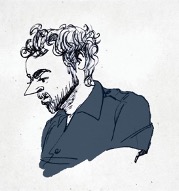
Kai Reimer-Watts is a current PhD student in Community Psychology at Wilfrid Laurier University, graduate of the Master of Climate Change program at UW, and director of the feature documentary for climate action Beyond Crisis, “a story of hope for a rapidly changing world” (www.beyondcrisisfilm.com) along with numerous short videos on climate. Kai's research and creative work explores the rich intersection of climate storytelling, the visual arts, movement-building and grassroots activism, centering on the powerful role of ‘signposts’ in both unifying and mobilizing a collective response to our climate change emergency. At a local level, Kai was the student lead for the ‘Climate is Life’ mural project on Laurier's Waterloo campus, collaborating with local mural artist Pamela Rojas and engaging several hundred people from across Laurier in the mural’s creation in Fall 2019. Kai was a contributing artist and community consultant for SPECTRUM in THEMUSEUM’s ALARM exhibit, “responding to our climate emergency”, which features work made and contributed by the broader regional movement for climate justice and continues to centre climate storytelling in short film works to support ongoing community dialogue and action.
Kai is an active member of the local movement for climate justice in Waterloo Region which has been leading regular strikes, art builds and creative actions for climate justice throughout the region; a leader on climate emergency campaigns locally resulting in successful declarations of climate emergency across five municipalities and the region in 2019, and is now building on these declarations as co-organizer of a region-wide campaign ‘50x30WR’ to demand Waterloo region commit to a 50% reduction in community-wide GHG emissions by 2030, informed by both climate science and justice (www.50by30wr.ca). Kai is co-founder of The People’s Climate Foundation and Climate Justice Laurier, advocating for bolder action for climate justice at Wilfrid Laurier University and beyond. Taken together, Kai’s work explores the power of collective radical imagination in response to crisis, to resist climate injustice and forge a far brighter future.
Portrait of the artist courtesy of animator-illustrator Abhilasha Dewan

Richard Watts is a land-based earth artist raised in the midwestern United States and on a family farm. Following his immigration to Toronto, Canada in 1987, Richard’s art practice now remains based at a live/work barn Studio in the Canadian Shield in Southern Ontario, exploring both an inner spiritual connection to nature along with environmental and climate change issues (see www.richardwattssculpture.com). Richard’s art practice is deeply material in nature, challenging the obsession with the digital that has overtaken Western culture by reclaiming a spiritual connection to materials and nature. Recent works include the “Earth Etchings” series – latex and gauze relief sculpture ‘prints’ or ‘paintings’ created from Canadian Shield rock faces, trees, vintage boats, and abandoned architecture (2008 – present). The boat forms, archetypes of collective and individual life cycles and journeys, also refer to the way the continent was originally traversed by Indigenous Peoples—in wood, bone, and skin crafts on the lake and river systems—as well as to the vehicles of European colonization and genocide. The forms also express current climate change population displacements and predictions of future mass migrations. The old growth tree forms are ancient world-symbols from which human culture evolved—cathedrals, or ships, both depended on them and classical columns and architectural proportions evolved from the old growth groves. With current climate change trajectories we will need many more old growth forests. The forms remind us to protect and nurture what remains.
Richard’s work has received feature print and television coverage, along with solo exhibitions and commissions. In 2007, the site-specific “Ark” was installed under the Manhattan Bridge, and a series of skeletal steel forms along Mission Creek, a salmon river, in Kelowna, British Columbia in 2006. In summer 2008 six cottage boats were altered live in front of Edmonton City Hall for The Works Festival, according to climate change themes, including a CBC presentation. In 2012 the “Earth Etchings” were first shown at the MacLaren Art Centre in a solo exhibition called The Three Seasons, and in 2014 travelled to Two Rivers Gallery in Prince George, British Columbia, as well as the International Earth Art Exhibition in Hamilton, Ontario at the Royal Botanical Gardens. A solo survey exhibition took place at the Tom Thomson Museum in Owen Sound from June – Sept. 2019. Reconnection is a collaborative show with his son Kai – both father and son continue to work through their art practice to respond to our human-made ecological crisis, reconnecting ourselves to each other and the natural world that sustains us.
Portrait of the artist courtesy of animator-illustrator Abhilasha Dewan
Artist Interview
Description of Artist Interview Video
INTERIOR. ROOM. Artist’s work hangs in front of a window and glows warmly as peaceful solo piano music plays.
TEXT ON SCREEN: Richard Watts, “Earth Etchings”
EXTERIOR. FOREST. The artists applies white substance to the bark of a large tree with a paintbrush. There are gentle wind and forest sounds.
RICHARD WATTS
A lot of what I do is mimic what insects do in their processes or animals, and I believe when we pay attention to that the more we understand our own processes as human beings and our own place in the world more.
EXTERIOR. FOREST. The artist sits in a chair in a field of yellow wildflowers. In the near distance are trees and a deciduous forest. As the artist talks, the scene changes to a close up of a caterpillar cocoon hanging form wood. In time lapse, it rapidly changes to become a butterfly.
RICHARD WATTS
So, this morning out here I found this cocoon. I don’t know what’s in it. I don’t know what kind of butterfly or moth might come out of it. Or caterpillar. But it’s going through a period of transformation. And the process of our lives involves various periods of transformation where we go into cocoons and we shed an old skin and we form a new one. And then we do that many times during our lives, not just once.
INTERIOR. MONTAGE. On the screen, the image pans through several images from the artist’s work, both original and illuminated. Strummed and plucked guitar music accompanies this montage which fades back to see the artist sitting outside.
EXTERIOR. FOREST. The artist sits in a chair in a meadow of yellow wildflowers. In the distance are trees and a deciduous forest. The soft guitar music continues underneath the artist speaking.
RICHARD WATTS
Because I’m a visual artist, the only way I know to explain these things is through my work. So, in a recent series I’ve been printing, the patterns that ants make, which I call ‘ant writing’, on logs as the logs decay.
INTERIOR. MONTAGE. On the screen, images of the artist’s work are displayed. These works are close-ups of the ant writing, where the swirling and zig-zagging patterns made by ants are filled with graphite and other metallic pigments. Some of these images are showcased on trees outside in nature, while others are removed and displayed in galleries.
RICHARD WATTS
It works best on cedar logs because those logs take longer to decay, and the ants make patterns under the bark and then they leave. And I’ve been printing these, filling them with graphite or gold and silver pigments because they look like writing. The reason I’m doing this is because I believe that’s a secret writing that is equally as sensible, equally as intelligent, as sophisticated formally as anything I can make or that I could write. I have lots of ideas. I have lots of concepts. I write them.
EXTERIOR. FOREST. The artist sits in a chair in a meadow of yellow wildflowers. In the distance are trees and a deciduous forest. The soft guitar music continues underneath the speaking.
RICHARD WATTS
They are a pattern that goes like this [draws wave pattern in air with finger], and then somehow that gets communicated to other human beings who understand the language I’m speaking.
INTERIOR. MONTAGE. A close-up video of a hand writing words with a pencil is shown.
EXTERIOR. FOREST. The artist is seen walking through a field towards a forest.
INTERIOR. MONTAGE. This is followed by another slideshow of images of the artist’s work, beginning with a fragment of a wooden boat whose materials make up some of the art, and ending with more gallery shots of the illuminated art pieces.
EXTERIOR. FOREST. The artist is pictured from behind, wearing a mosquito net hat and pressing strips of gauze onto the bark of the tree that he was painting earlier.
RICHARD WATTS
The word ‘artist’ gets thrown around a lot with a lot of cultural associations as to what that means. Partly what I’m trying to do through my work is erase myself. I think, as human beings, we’ve said too much. I say too much. We need to say less and let other lifeforms speak more, and learn from what they say.
EXTERIOR. FOREST. A video montage shows close-up clips of blades of grass, wildflowers, the leaves of the forest canopy, and a rushing stream with a waterfall. The sounds of the natural environment are heard, including insect buzzing, birds chirping, wind through the trees, and the flowing water.
INTERIOR. MONTAGE. More images of the artist’s work are shown on screen. In addition to the illuminated nature works with canoes, ant writing, and tree bark, there are pieces involving metal scraps including pipe joints and piles of metal rubble outlined by fine strands of lights.
EXTERIOR. FOREST. The shot returns to the artist speaking from his chair in a field of yellow wildflowers with trees and a deciduous forest in the near background.
RICHARD WATTS
There’s a lot of different kinds of artists, just like there’s a lot of different kinds of scientists or a lot of different kinds of doctors. I consider it an important profession in the sense that an artist is kind of like the safety valve or the ‘id’ of a culture, and so their job is to draw attention to or get people to focus on things that are important and the underlying structure of our culture that people might not look at otherwise.
INTERIOR. MONTAGE. Aerial pan of a gallery shows the artist’s work displayed. The pieces extend from floor to ceiling and are all illuminated from behind. Images show old canoes set up in the gallery space as part of the exhibit. The soft plucked and strummed guitar music continues.
EXTERIOR. FOREST AND RIVER. People paddling a red canoe down a river are seen from a distance. People are visible sitting on the shore from behind, looking at the water. The next shot is of the artist from behind riding a bike down a path surrounded by trees; he is only visible from the shoulders up. Finally, the shot returns to flowing water and a gentle waterfall tempered by rock ledges with trees outlining the top level of the waterfall. The shot zooms in so just the rushing water is seen.
RICHARD WATTS
The ones when I’m working with them that are old Canadian canoes are part of Canada’s core mythology of travelling across the country in a vessel where this metaphor for connecting the wilderness and for couples. It’s this romantic image. So, there’s spirits in old canoes and there are relationships in old canoes. But they’re also once again like cocoons.
EXTERIOR. FOREST. The shot returns to the artist speaking from his chair in a field of yellow wildflowers with trees and a deciduous forest in the near background.
RICHARD WATTS
Like you put a canoe on top of another canoe, and you’ve got a cocoon. And then if you wrap something around it and put two people in there, you don’t know how they’re going to come out afterwards.
INTERIOR. MONTAGE. More gallery shots of the artist’s work.
RICHARD WATTS
And for some reason, yes, they seem like people that are talking to each other, there are things happening between the forms. But the backs of their heads are pointed away, which are their private thoughts. So, there’s this connection and disconnection, but they have to get along or the canoe won’t move – it’s a very pregnant metaphor for me. And it’s a series that could go on my whole life because every canoe ends up with a different canoe people image that comes out of it.
EXTERIOR. FOREST. The shot returns to the artist speaking from his chair in a field of yellow wildflowers with trees and a deciduous forest in the near background.
INTERIOR. MONTAGE. Close up pan over some details of the artist’s work, including the texture of illuminated bark and metal canoe structures resembling a human spine with ribs.
TEXT ON SCREEN: Richard Watts, www.richardwattssculpture.com
INTERIOR. MONTAGE. Shot returns to the opening piece of artwork hanging in front of a window while peaceful solo piano music plays.
TEXT ON SCREEN: solo piano, Keenan Reimer-Watts. “The circles I went round in’, by Doctor Turtle.
Signposts
Description of Signposts Video
This video Signposts: Responding to Crisis is a series of ‘video portraits’ of 29 different participants, stitched together back to back over 12 minutes.
Text on screen appears into the silence.
"In summer 2020, in the midst of a global viral pandemic, climate crisis, economic collapse, racist violence and – as if this was not enough – so much other hardship also being visited on people, we put out a call for portraits responding to one simple question: "
Ambient music emerges from the background.
The text is replaced with "if you could share one message with the world in response to crisis, what would it be?
Ambient music gets louder
The text is replaced with "This is what we received.”
The remainder of the video includes a series of portraits received in response. Each portrait includes a person or several people holding a sign and facing the camera.
The first portrait fades in. You see a woman holding a sign that reads: “Please help people – one love”.
The ambient music intensifies as the camera pulls back slowly to show more of the background of a small home near a mobile home with spray painted word, Tent City. The video transitions through black to the second video portrait.
In the second portrait, you see the back of someone’s jacket that reads “Every great injustice has been at the hands of someone following orders”. The person is in a parking lot with parked police cars, and walks past them slowly. There is the faint sound of cars in the distance. The video fades through black to the next video portrait.
In the third portrait, you see a group of people in front of a teepee, holding a banner that reads “Honour the treaties – we are on Indigenous land.” The ambient music slowly returns. Birds chirp in the background as the ambient music gets louder. The image transitions to the fourth image.
In the fourth portrait, you see two people, a man and a woman, standing on a busy street corner in downtown Kitchener, holding a sign that reads “Divest from an extractive economy. Invest in a fair, compassionate, regenerative future.” There is traffic sounds and the screeching of construction equipment. The image transitions to the fifth video as contemplative keyboard music appears.
In the fifth portrait, you see three people holding a colourful blue and green banner that reads “Join Communities for Climate Justice: Act Now” with a flock of birds printed onto the banner. The people are surrounded by pairs of shoes, donated for the Shoe Strike for Climate Justice in Waterloo Public Square. There is chatter of people talking in the background. The video transitions.
In the sixth portrait, you see a person holding a sign that reads “Leading with love means we leave nobody behind. Not now. Not ever”. There is a babble of running a small waterfall and flowing water as the contempleative keyboard music continues. The video transitions.
In the seventh portrait, you see a person holding a sign in French that reads “Renforcer le filet social et fournir de l’aide a la population”, which translates as “Strengthen the social safety net and provide relief directly to people”. Birds chirp, the wind rustles through leaves of tress, the contemplative music continues, and children's voices are heard from off-screen. The video fades through black.
In the eight portrait, you see a person holding a sign that reads “50% less emissions by 2030 for a livable climate”. This is held in front of a large mural on a brick wall, the colourful “Climate is Life” mural on Laurier’s Waterloo campus. Indistinct talking and yelling in the background the music fades out leaving the hum of ambient noises from the city. Fade through black.
In the ninth portrait, you see a person holding a sign that reads “White supremacy is a hydra … The heart must be cut out as the heads are cut off”, with an image of the mythical hydra breathing fire and bleeding beneath it. The sound of leaves rustling in the wind and indistinct voices talking are the background as omnious electronic frequencies build up.
In the tenth portrait, you see a person holding a sign that reads “Everybody matters! We are all interconnected. Let’s start acting accordingly”, with different flowers attached to the image. The musiic, rustling leaves, and wind continues. The sound of flowing water appears. The music stops. Fade through black to the next video portrait.
In the eleventh portrait, you see a person holding a sign that reads “Climate change is not an environmental problem, it’s a people problem”, standing in a busy square in downtown Toronto. Faraway sounds of piano music pay amidst street noise, and other indistinct city sounds, inlucing car engines and people chatters. Street drums bang and someone sings indistinctly. Fade through black.
In the twelfth portrait, you see a person holding a sign that reads “Hope has two beautiful daughters: Anger at the way things are, and courage to change them”. Birds chirping, guitar pucking as indistinct laughter and chatter comes from off-screen. Fade to the next video portrait.
In the thirteenth portrait, you see a person holding a sign with a giant water droplet on it and text that reads “I am clouds above you. I am the aquifers below. I am the air you breathe. I am the tears you weep. Respect me”. Soft ambient noise in a park. Joyful guitar plucking plays. Fade to the next image.
In the fourteenth portrait, you see a person holding a sign that reads “Out with the old, in with the new” with an image of dirty energy, water, and clean energy powered by the sun. Birds chirping, wind rustling leaves, as the music becomes repetitive trance-like music. Transition to the next image.
In the fifteenth and final portrait, you see three people standing next to a large mural painting showing children playing in nature that reads “We’re stronger together”. The repetitive trance-like music continues. Fade through black
The final scene shows all fifteen portraits side by side together. Repettive trance-like music continues. A loud truck noise appears. The credits appear.
Fade to black
Blast Wall

Description of Blast Wall
Blast Wall is an Earth Etching made by the artist Richard Watts in 2008. It is made from granite and quartz fragments, rust, vulcanized latex rubber, cheesecloth layers (to weave canvas), LED lightbox (to frame), and embedded dried flora in crevice. It was made off a blast wall in Belmont Rose Granite Quarry, near Havelock, Ontario. It is seen lit from behind in the image.
Blast Wall, 2008, 48.5” x 73”
Granite and quartz fragments, rust, vulcanized latex rubber, cheesecloth layers (to weave canvas), LED lightbox (to frame), embedded dried flora in crevice.
Made off a blast wall in Belmont Rose Granite Quarry, near Havelock, Ontario.
Wild Grape Vine Couple on Lath Wall
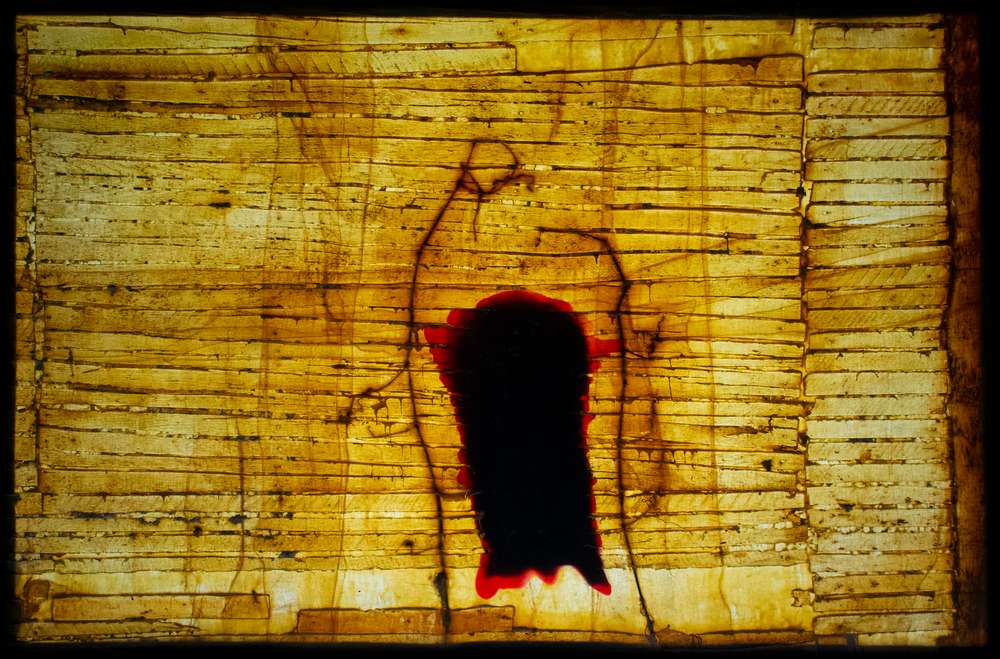
Description of Wild Grape
Wild Grape Vine Couple on Lath Wall is an Earth Etching made by the artist Richard Watts in 2009. It is made from vulcanized latex rubber and cheesecloth layers (to weave canvas), colour leached from tannins in lath strips on wall, rust dots from nails, wild grape vines, urethane resin, and an LED lightbox (to frame). It was made in the Mason House, an abandoned farmhouse near Havelock, Ontario. It is seen lit from behind in the image.
- Reuse
- Embed
Wild Grape Vine Couple on Lath Wall, 2009, 50" x 75”
Vulcanized latex rubber and cheesecloth layers (to weave canvas), colour leached from tannins in lath strips on wall, rust dots from nails, wild grape vines, urethane resin, LED lightbox (to frame).
Made in the Mason House, an abandoned farmhouse near Havelock, Ontario.
Maple Tree Fork: Bison Spirit
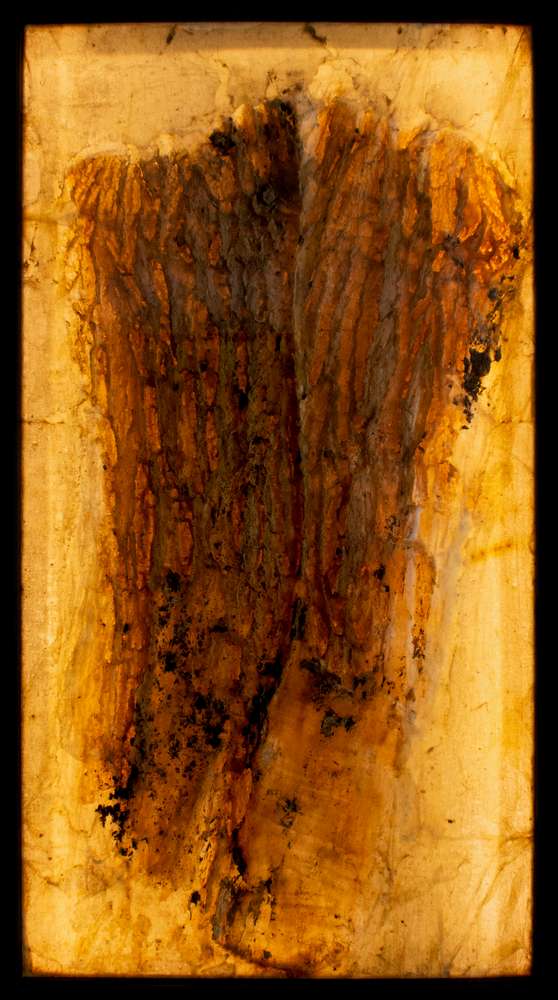
Description of Maple Tree Fork: Bison Spirit
Maple Tree Fork: Bison Spirit (also a Torso), is an Earth Etching made by the artist Richard Watts in 2017. It is made from fragments of maple bark, vulcanized latex rubber, cheesecloth layers (to weave canvas), and an LED light box (to frame). It is seen lit from behind in the image. 32” x 57”
Maple Tree Fork: Bison Spirit (also a Torso), 2017, 32” x 57”
Fragments of maple bark, vulcanized latex rubber, cheesecloth layers (to weave canvas), LED lightbox (to frame).
Maple Tree: Horse Spirit

Description of Maple Tree: Horse Spirit
Maple Tree: Horse Spirit is an Earth Etching made by the artist Richard Watts in 2017. It is made from Fragments of maple bark, colour from tannins in tree, vulcanized latex rubber, cheesecloth layers (to weave canvas), and an LED light box (to frame). It is seen lit from behind in the image. 32” x 57”
Maple Tree: Horse Spirit, 2017, 32” x 57”
Fragments of maple bark, colour from tannins in tree, vulcanized latex rubber, cheesecloth layers (to weave canvas), LED lightbox (to frame).
Canoe People

Description of Canoe People
Canoe People I: Center Section is an Earth Etching made by the artist Richard Watts in 2008. It is made from vulcanized latex rubber, cheesecloth layers (to weave canvas), cedar strip tannins, embedded porcupine quills, dried flowers, fragments of canoe, dots from copper leached from rivets, and an LED light box (to frame). It is seen lit from behind in the image. 51” x 82”
Canoe People I: Center Section, 2008, 51” x 82”
Vulcanized latex rubber, cheesecloth layers (to weave canvas), cedar strip tannins, embedded porcupine quills, dried flowers, fragments of canoe, dots from copper leached from rivets, LED lightbox (to frame).
Mason Boat
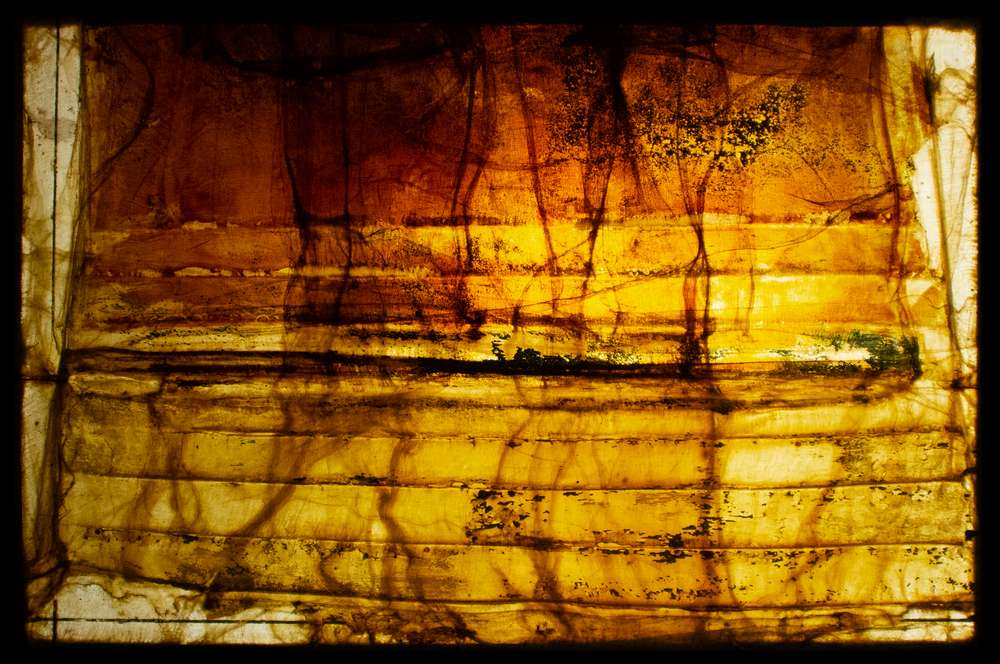
Description of Mason Boat 1
Mason Boat 1 is an Earth Etching made by the artist Richard Watts in 2013. It is made from vulcanized latex rubber, cheesecloth layers (to weave canvas), paint embedded from hull of boat, and an LED light box (to frame). This piece was made off an old Mason boat from Nova Scotia that was found near Havelock, Ontario. There seems to be a face in it like a fisherman heading home. It is seen lit from behind in the image. 50” x 75”
Mason Boat 1, 2013, 50” x 75”
Vulcanized latex rubber, cheesecloth layers (to weave canvas), paint embedded from hull of boat, LED lightbox (to frame).
This piece was made off an old Mason boat from Nova Scotia that I found near Havelock, Ontario. There seems to be a face in it like a fisherman heading home.
Surfacing
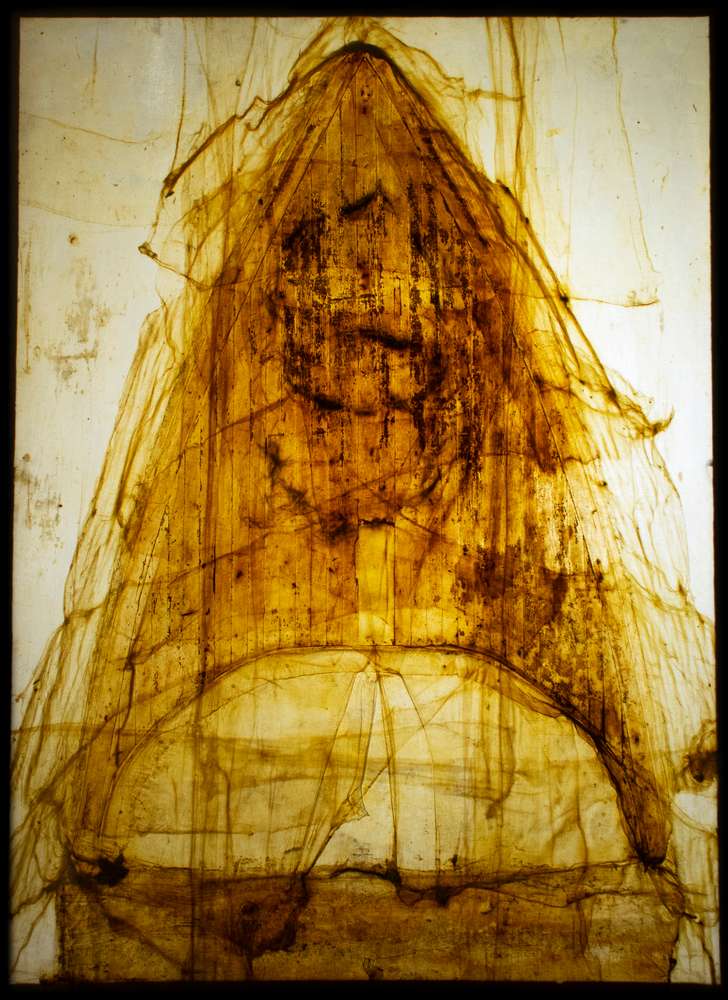
Description of Surfacing
Surfacing is an Earth Etching made by the artist Richard Watts in 2009. It is made from vulcanized latex rubber, cheesecloth layers (to weave canvas), leaves and porcupine quills, impressions of old boat hull/paint from board, and an LED light box (to frame). It was made from the prow of a vintage Peterborough Lakeside boat. It is seen lit from behind in the image. 71” x 95”
Surfacing, 2009, 71” x 95”
Vulcanized latex rubber, cheesecloth layers (to weave canvas), leaves and porcupine quills, impressions of old boat hull/paint from board, LED lightbox (to frame).
Made from the prow of a vintage Peterborough Lakeside.
Turtle Island
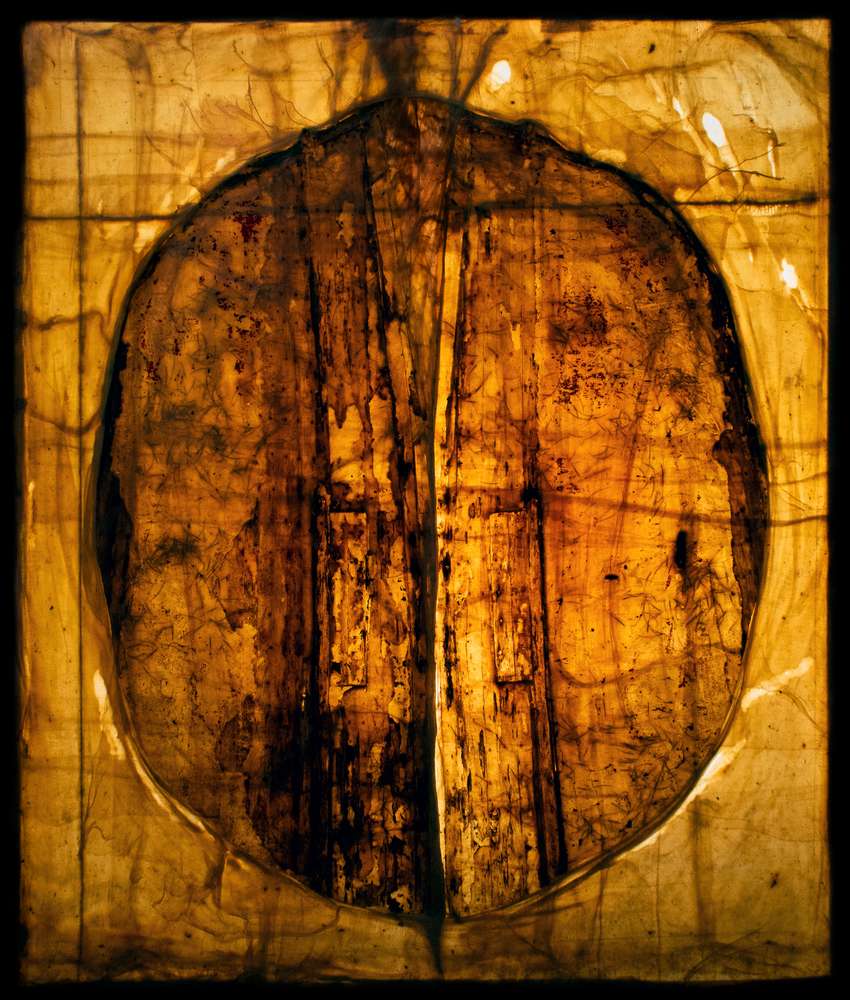
Description of Turtle Island
Turtle Island is an Earth Etching made by the artist Richard Watts in 2009. It is made from vulcanized latex rubber, cheesecloth layers (to weave canvas), fragments of paint and wood from an old boat, and an LED light box (to frame). The piece was made off of two sides of the prow of a vintage red rowboat found on Gold Lake, Ontario, in the Kawarthas. It is seen lit from behind in the image. 77” x 90”
Turtle Island, 2009, 77” x 90”
Vulcanized latex rubber, cheesecloth layers (to weave canvas), fragments of paint and wood from old boat, LED lightbox (to frame).
This piece was made off of two sides of the prow of a vintage red rowboat found on Gold Lake, Ontario, in the Kawarthas,
Insect Writing on Cedar Tree (Cuneiform)
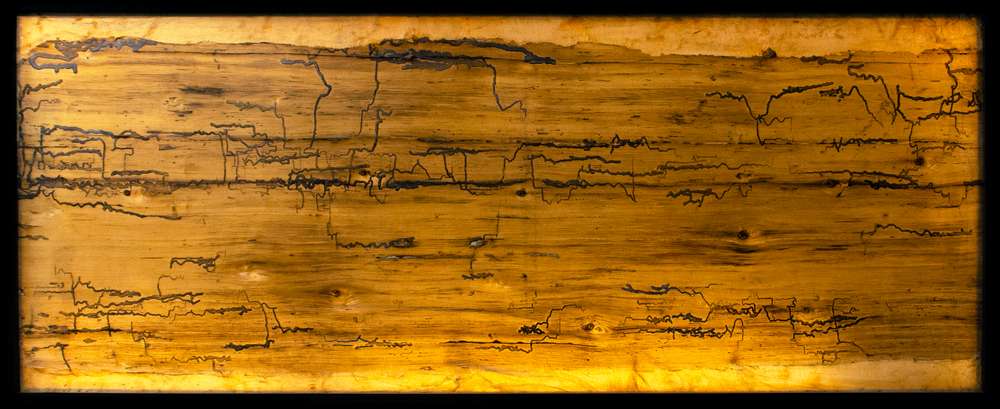
Description of Insect Writing on Cedar Tree
Insect Writing on Cedar Tree (Cuneiform 1) is an Earth Etching made by the artist Richard Watts in 2017. It is made from vulcanized latex rubber, cheesecloth layers (to weave canvas), fragments of cedar bark and other tree elements, some metallic pigments and graphite embedded into beetle carving patterns, and an LED lightbox (to frame). It is seen lit from behind in the image.
Insect Writing on Cedar Tree (Cuneiform), 2017, 31" x 78"
Artist Profile video
Description of Artist Profile Video
TEXT ON SCREEN: Richard Watts, www.RawArt2.com
EXTERIOR. FOREST. The artist is wearing a mosquito net hat and applies gauze and latex to a tree trunk to create an Earth Etching. Birds are heard chirping in the background and the artist breathes heavily at the effort of the work.
EXTERIOR. FOREST. The shot widens and the artist is pictured standing on a ladder to press the gauze and latex higher on the tree trunk. Background forest sounds are heard including insects buzzing and birds chirping.
EXTERIOR. FOREST. A close up shot pictures the artist applying the gauze and latex to the tree trunk. There is the crinkle of leaves as he steps around the trunk, breathing heavily.
EXTERIOR. FOREST MONTAGE. A slideshow of photos begins, capturing more of the setup and process of creating the Earth Etching. The first photo shows the ladder and the coated tree trunk. The second photo shows the whole trunk of the tree from a distance to reveal the size of the artwork; the gauze has started to peel back at the top of the tree trunk, revealing the imprint of the tree bark pattern. The third photo shows another angle of this shot. The fourth photo is a close up of the gauze peeling from the trunk to show the bark imprint. The fifth photo is another angle of this close up with more light to reveal the texture of the bark imprint. The song ‘Svefn-G-Englar' by the Icelandic band Sigur Ros (used with permission) begins to play, created an indistinct electronic atmosphere. The sixth photo pans over the artist’s work site, including seeing a barn and a trailer at the cusp of a forest, and the artist at work on the tree cast.
INTERIOR. GALLERY MONTAGE. A slideshow of exhibition photos begins. In the first photo, a finished Earth Etching is visible and hanging horizontal on the wall; in the background a similar art piece is hanging vertical over a window and is illuminated naturally from behind. The second photo is a closeup pan over the textural details of the vertical art piece. The third photo shows the vertical art piece and screen is split with a photo from the forest where the gauze and latex cast is peeling off of the tree that produced this Earth Etching. The fourth photo shows the artist with a tree covered in gauze and latex beside a tree that is untouched. The Sigur Ros music continues.
INTERIOR. BOAT MONTAGE. A slideshow of photos switches to the hull of a wooden boat covered in gauze, similar to the trees. The second photo shows the blue paint peeling off of the aging wood hull. The third photo shows gauze covering two sides of the broken remains of part of the boat, where the texture of the wood slats is visible. The fourth photo shows the back of this boat when the gauze is beginning to be pulled back, revealing the smooth wooden texture. The fifth photo is of the gauze illuminated from behind where the impression of the slats of wood is visible. The sixth photo is of a wooden boat frame outdoors; covered in gauze, the sunlight shines through the parts of gauze which do not have wood behind them based on where there are holes in the boat. The seventh photo is of the gauze peeling off of the boat frame. The eighth photo pans across the etching of the boat on the gauze.
INTERIOR. GALLERY MONTAGE. A slideshow of exhibition photos begins. The first photo shows a canoe suspended close to the ground in the middle of a gallery. On the walls are the imprints of the boat hull and frame which were pictured covered in gauze in the previous montage. The second photo is a close up of a work of art with an indistinct texture. The third photo is of a piece of art resembling a gauze imprint of a canoe frame. The fourth photo is of a vertical canoe imprint with a horizontal boat hull imprint on either side, abstractly resembling a totem pole. The fifth photo is a pan of a still forest shot where a small wooden shed structure is visible. The sixth photo is a close up of a textured imprint. The seventh photo is of an indistinct imprint on display and illuminated from behind; the silhouette of a person is seen in front of the piece to provide scale – the art is three times taller than the figure. Beside this, another art piece flashed on the screen. The eighth photo is a close up of an imprint where the texture of wooden boat slats is visible. The ninth photo is a closeup of the texture of this art piece. The tenth photo is a quick pan over works of art hanging side by side until two vertical Canoe People images fill the screen, one natural and one illuminated from behind; from a distance they resemble people wearing hoods with their backs toward each other. The eleventh photo is of two horizontal Canoe People images hanging side by side in a gallery. The twelfth photo is of the length of a full canoe imprint hanging in a room with a high ceiling, revealing the width of the art piece as being practically as wide as the room itself.
EXTERIOR. ROCK WALL MONTAGE. The artist is pictured spreading gauze and latex over a rock wall that has manmade vertical impressions in it alongside one distinct crack running horizontally through the rock. The second photo is of the artist spreading gauze and latex over a different rocky surface. The third photo is of an imprint of the rock texture that almost resembles tree bark. The fourth photo is a closeup of gauze and wooden materials.
INTERIOR. ART MONTAGE. The image on the screen is a drawing of bare trees with snippets of the Earth Etching tree bark texture surrounding the figures. The second photo is a drawing with indistinguishable words that shows a three-sided rectangular area; the screen zooms in on part of the drawing that shows what resembles the earlier boat hull structure. The third photo is a drawing of a boat hull with many pipes and structures sticking through it. The fourth photo shows a gallery space with a boat hull suspended in the middle of the room, and metal art structures on the wall and connected to the boat hull which resembles the earlier sketches; the screen zooms in on the boat hull. The fifth photo is darkened with light cast on the interior of the boat hull, and the shadow of the wooden slats is seen on the wall behind the hull. The sixth photo is of the boat hull in an outdoor city setting at night, faintly illuminated under a bridge with streetlights and a tree in the distance. The seventh photo is of the front angle of this boat hull and the tree in the background looks as though it is emerging from the boat itself. The eighth photo is of a different boat structure, this one made of metal and more abstract, almost resembling a human spine with ribs. The ninth photo zooms through the inside of this metal boat structure as though it is a tunnel, revealing the symmetry of both of its sides. The tenth photo is an exhibition shot of a suspended canoe that’s missing half of its bottom; the shadow of the canoe is seen on the floor. The screen fades to black, and text appears.
TEXT ON SCREEN: Richard Watts, www.RawArt2.com. Svefn-G-Englar music provided with permission from Sigur Rós. Video by Better Creative.
Cubicle People
Description of Cubicle People
This is a 7 minute video that begins with a close-up image of torn fabric and insulation, and a broken spray painted desk.
There is light, cheery music playing. A series of close-ups reveal a cut up office cubicle. The sound of cincadas rise off-screen and drop in the transition to the next close-up of the bristles on exposed insultation within the cubicle walls.
As crickets chrip in forest noise, text overlaid on the video reads:
“hello?
(yes, you).
we’ve missed you…”
The images changes and there are footsteps crunching leaves on the forest floor. Birds call out. The video title appears:
CUBICLE PEOPLE
The next scene reveals a cut-up, spray painted cubicle in which figures of people have been cut out of the cubicle. The cubicle is in the centre of a forest, and you can see a large pine tree rising up behind it. There is a gentle wind rustling the leaves of the tree canopy. The screen fades to black.
The music changes to something more moody. A title appears on the screen
cubicle
Cut to the cubicle prior to being cut, with images of people drawn on its interior walls. Footsteps crunch leaves along the forest floor.
Cut to a man with a hat drawing on the cubicle chair, desk and keyboard, which is next to a computer monitor and speakers. There is a squeak of permenant marker on desk surface. Birds and insect noise sounds in the forest background.
The man begins spray painting outlines of the people, as the music becomes more sinister. There is a sound of spraying paint and the artist shaking ball bearing in the can. This sound of spaying paint goes on for some time.
A fast montage of close-ups of the cubicle in black-and-white is played. This switches to a black-and-white image of the full spray painted cubicle. Crickets and forest noises accompany the cubicle. Then the screen fades to black and the title appears:
cut
You can hear the hum of an electric saw beginning to cut out the figures in the cubicle fabric walls.
Slow, atmospheric piano music begins to play. Each of the figures drawn onto the cubicle are cut out one by one.
There forest rustling and chirping along with the rattle of computer rocking on desk from the impact to the cubicle wall. Footsteps crunching through leaves on forest floor as the artist walks from behind the cubicle wall the front. The artists bangs the dormant saw on the cubicle wall to push the cutout through.
The electric saw buzzes as it rattle and cuts the plastic computer monitor slowly in half. The rattle and buzz of sawing through the fabric cubicle wall continues again. The atmospheric music continues.The desk plant has a leaf cut off.
The screen fades to black with the title
opening (to free the people)
There is hefty ripping sounds. Video of the cubicle structure being dismantled appears.
The scene becomes color, with an opening created through the cubicle and through one of the figures. You can hear the sound of cicadas and slow moody music. The camera pans across the cubicle wreckage, before zooming into one of the figure cutouts, revealing only the forest beyond.
Fade to black.
Credits
'cutting a cubicle'
starring
cubicle people
kai reimer-watts
richard watts
'walking in despreston promo shorter'
Ai Yamamoto
'Ghost Byzantine'
Blue Dot Sessions'
'I Recall'
Blue Dot Sessions
a film by
kai reimer watts
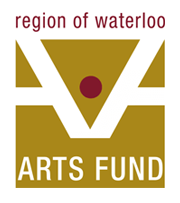
Reconnection gratefully acknowledges the financial support of the Region of Waterloo Arts Fund
